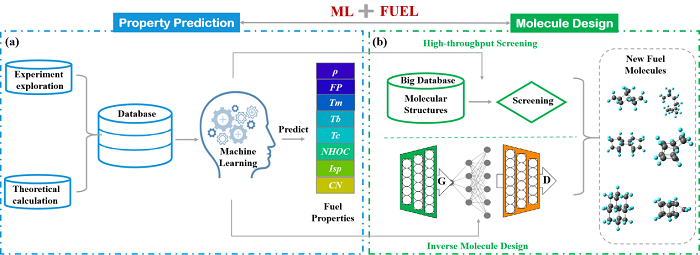 PDF(17035 KB)
PDF(17035 KB)


Machine Learning Assisted Molecule Design of Fuel
Zhang Xiangwen, Hou Fang, Liu Ruichen, Wang Li, Li Guozhu
Prog Chem ›› 2024, Vol. 36 ›› Issue (4) : 471-485.
 PDF(17035 KB)
PDF(17035 KB)
 PDF(17035 KB)
PDF(17035 KB)
Machine Learning Assisted Molecule Design of Fuel
theoretical design of fuel has always been the focus of research about fuel in the area of propulsion technology.It can effectively overcome the complexity and potential danger of the experiment,and guide experimental synthesis of fuel,which can be verified by experimental results.It is anticipated that a new generation of fuel can be efficiently designed for subsequent fuel synthesis and application.However,the traditional Theoretical calculation methods,such as group contribution method and quantum chemical method,have the defects of low accuracy and efficiency.machine learning,a rapidly developed algorithm,has opened up a new way to design potential high-energy fuels,which exhibits strong capabilities in both property prediction and molecule design.in this review,several fuel molecule descriptors for machine learning are introduced,and different machine learning models for fuel property prediction and molecule design are briefed.Furthermore,the research on machine learning assisted property prediction and new molecule design of fuel is summarized,respectively.Finally,the challenges and future development of machine learning applied in fuel design are discussed。
1 Introduction
2 Fuel molecule description method
2.1 Molecular fingerprinting based on SMILES
2.2 Coulomb matrix
2.3 Continuous operable molecular entry specification
2.4 Molecule graph
3 Machine learning model
3.1 Model for fuel property prediction
3.2 Model for fuel molecule generation
4 Fuel property prediction
4.1 Single fuel property prediction
4.2 Multiple fuel properties prediction
5 Design of new fuel molecules
5.1 High throughput screening of fuel molecules
5.2 Reverse design of new fuel molecules
6 Conclusion and outlook

fuel / machine learning / molecule description / property prediction / molecule design / high-throughput screening
| [1] |
( 邹吉军, 郭成, 张香文, 王莅, 米镇涛. 推进技术, 2014, 35(10): 1419.)
|
| [2] |
|
| [3] |
( 余锐, 刘显龙, 史成香, 潘伦, 张香文, 邹吉军. 含能材料, 2022, 30(11): 1167.)
|
| [4] |
( 刘宁, 史成香, 潘伦, 张香文, 邹吉军. 燃料化学学报, 2021, 49(12): 1780. )
|
| [5] |
( 潘伦, 李怀宇, 薛康, 张香文, 邹吉军. 推进技术, 2023, 44(09): 6.)
|
| [6] |
( 潘伦邓, 鄂秀天凤, 聂根阔, 张香文, 邹吉军. 化学进展, 2015, 27(11): 1531.)
|
| [7] |
|
| [8] |
|
| [9] |
|
| [10] |
|
| [11] |
|
| [12] |
|
| [13] |
|
| [14] |
|
| [15] |
|
| [16] |
|
| [17] |
|
| [18] |
|
| [19] |
|
| [20] |
|
| [21] |
|
| [22] |
|
| [23] |
|
| [24] |
|
| [25] |
|
| [26] |
|
| [27] |
|
| [28] |
|
| [29] |
|
| [30] |
|
| [31] |
|
| [32] |
|
| [33] |
|
| [34] |
|
| [35] |
|
| [36] |
|
| [37] |
|
| [38] |
|
| [39] |
|
| [40] |
( 张弛, 郭媛, 黎明. 计算机工程与应用, 2021, 57(11): 57.)
|
| [41] |
|
| [42] |
|
| [43] |
|
| [44] |
|
| [45] |
|
| [46] |
|
| [47] |
|
| [48] |
|
| [49] |
|
| [50] |
|
| [51] |
|
| [52] |
|
| [53] |
|
| [54] |
|
| [55] |
|
| [56] |
|
| [57] |
|
| [58] |
|
| [59] |
|
| [60] |
( 邹吉军, 张香文, 王莅, 米镇涛. 化学推进剂与高分子材料, 2008, 6(1): 26.)
|
| [61] |
( 熊中强, 米镇涛, 张香文, 邢恩会. 化学进展, 2005, 17(02): 359).
|
| [62] |
|
| [63] |
|
| [64] |
|
| [65] |
( 高月, 张向倩, 张子炎, 张金梅, 王亚琴, 张宏哲. 中国安全生产科学技术, 2020, 16(10): 20.)
|
| [66] |
( 宋晓亚, 潘勇, 蒋军成, 徐迅. 安全与环境学报, 2016, 16(6): 133.)
|
| [67] |
|
| [68] |
|
| [69] |
|
| [70] |
|
| [71] |
|
| [72] |
|
| [73] |
|
| [74] |
|
| [75] |
|
| [76] |
|
| [77] |
|
| [78] |
|
| [79] |
|
| [80] |
|
| [81] |
|
| [82] |
|
| [83] |
|
| [84] |
|
| [85] |
|
| [86] |
|
| [87] |
|
| [88] |
|
| [89] |
|
| [90] |
|
| [91] |
|
| [92] |
|
| [93] |
|
| [94] |
|
| [95] |
|
| [96] |
|
| [97] |
|
| [98] |
|
| [99] |
|
| [100] |
|
| [101] |
|
/
| 〈 |
|
〉 |